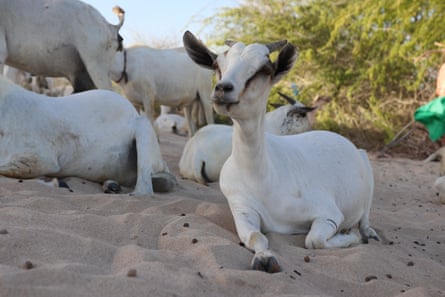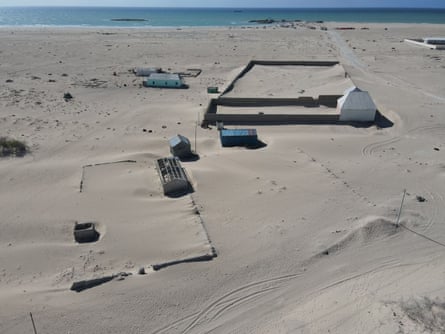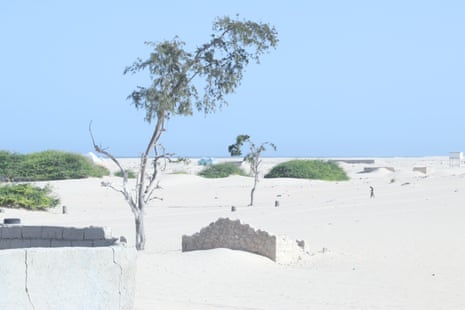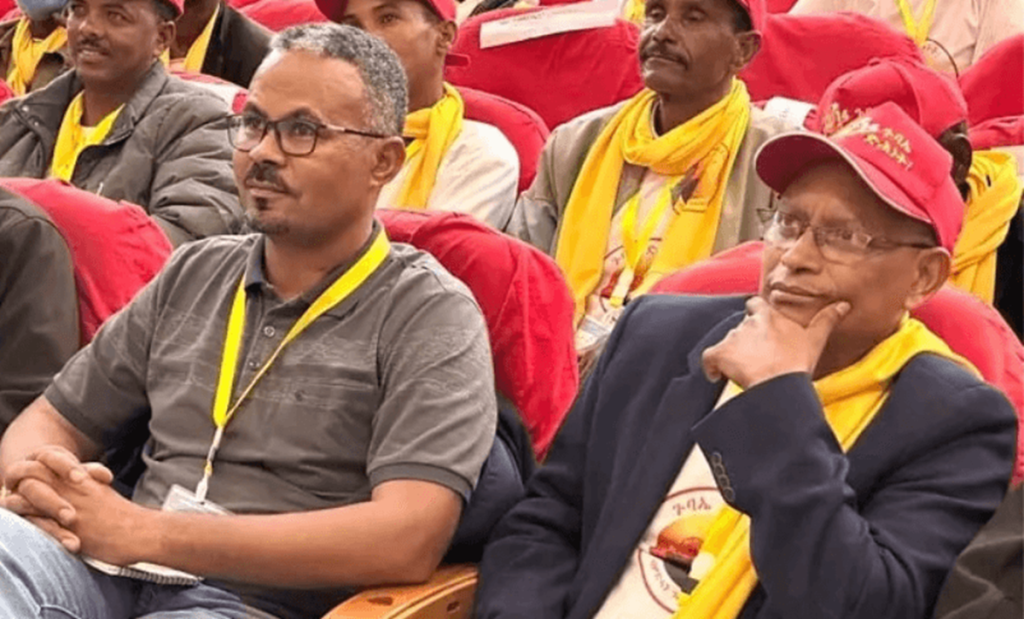Hussein Karshe paces back and forth across the sand on the outskirts of the coastal town of Hobyo. Beneath the soft white dune lie the remains of the two-bedroom house he built for his family in 1993. A few sticks buried below the sand are the only visible sign of the building where his six children were born. Karshe lived there for nearly 20 years, supporting his family by selling goats.
But in 2011 heavy sandstorms covered the ground around his home. Over the next year the sand accumulated, creeping up the external walls of the house and blowing into the rooms. At first Karshe tried to keep the sand at bay by scooping it out with his hands or a small shovel, but his efforts proved futile.
Realising he was powerless to stop it, Karshe could only look on as the sand built up inside the rooms. He decided to build a new house nearby, hoping that the sandstorms that regularly blast this stretch of Indian Ocean coastline would reduce in ferocity and that the local authorities might provide some support to those affected.
Neither of those things happened. After three years, sand engulfed the new home and the family were forced to move again.
Today, the 70-year-old former air force technician lives with his wife and daughters in two tents made from cloth, cardboard, car wheels and other scraps. Every morning he leads his herd of goats inland in search of grazing. Repeated droughts mean he sometimes has to travel for up to two days to find fertile ground.




Karshe moved to the port of Hobyo from Somalia’s capital, Mogadishu, after the collapse of the central government in 1991, hoping that the town, in the Mudug region of central Somalia, would be a safe haven from the civil war that tore much of the country apart. He could not have predicted that the climate crisis would displace his family again.
“As you can see, my [second] house is succumbing to sand,” he says, pointing to the knee-deep sand in the rooms as the metal roof creaks in the wind. “It’s all I have left after three decades in Hobyo. I’ve lost everything. All I have left are memories.”
Founded in the 13th century during the Ajuran empire, Hobyo became a hub for piracy, an activity that peaked in 2009-10. Since the decline in piracy, attention has shifted from criminal activity along the coast to the region’s environmental degradation.

Despite contributing less than 0.08% of global emissions, Somalia is one of the most climate-vulnerable countries in the world. Droughts, strong winds and soil erosion are just some of the effects that have worsened over the past two decades as the climate crisis has intensified, causing extreme suffering, including near-famine conditions and mass displacement.
On the coast people say they are more vulnerable than ever to sandstorms that have buried homes, shops, schools and hospitals. In Hobyo, home to about 11,000 people, a hospital funded by a local man, Sheikh Hassan Hussein, was buried in sand just a year after it was built in 2018.
There are fears that the town’s main hospital, where sand is more than a metre high around some of the external walls, will also be buried if no action is taken soon.
Mohamed Mohamud, from the Somali conservation organisation Greenwatch Trust, says: “Wind is one of the factors that is affected by climate change. If you ask the coastal communities, they are saying that the wind is stronger than ever, in comparison to the last 30 years. They said [strong winds] existed before but [they are] faster.”

Karshe’s family is one of 600 – approximately 3,000 people – displaced by the encroaching sand between 2011 and 2023, according to the director of social affairs in Hobyo, Shariff Shure. “My own home was completely engulfed in sand in 2010,” says Shure.
Muna Abdi Ahmed, 36, is a widow and mother of six. “I tried to build a home for my children on the land we inherited from my late husband, hoping to provide my children with a proper place to call home and keep a piece of their father with them,” she says.
“I sold my entire livestock to begin building the house but the work came to an abrupt halt in 2021 due to the rising sand dunes.

“Now my children and I languish in a makeshift tent. The home I wanted to build for my children is nothing more than a pile of rubble in sand.”
Hobyo is not the only place facing this fate. Towns in the south-central region, including Dinowda, Warsheikh, Cadale, Masagawaay, Ceeldheer, Hoodleey and Harardhere, are being slowly entombed.
“Cadale lost the only secondary school they have, as sand is covering the city. I was there a month ago. I spoke to a colleague in Barawe and they have the same scenario,” says Mohamud.

-
‘I tried to build a home for my children on the land we inherited from my late husband,’ says Muna Abdi Ahmed, standing by her temporary home in Hobyo
In Dinowda, 90 miles (150km) north of Hobyo, 800 families were displaced after their homes were buried in February 2021. Schools, mosques and health facilities have also been engulfed.
In March this year sand dunes blocked roads preventing lorries from delivering food and other vital goods to Dinowda from the port of Bosaso. Instead of three deliveries during the month, they only came once, causing food prices to double. Wells were also blocked or contaminated by sand, leading to water shortages.
“I have seen what has happened with Dinowda. No one did anything. The community gave some contribution, but the government didn’t do anything,” says Abdilatif Hussein Omar, a lecturer in the department of environmental sciences at Somali National University.
“And the same thing is going to happen right now in Hobyo. If the government doesn’t take any tangible action, Hobyo will be taken over by the sand. So there will be no history at all,” says Omar, who is also director of the conservation organisation Action for Environment.

Climate change is driving the problem, say Omar and Mohamud, of Greenwatch Trust.
“Climate change is the main issue. Whenever the global temperature increases, we have a lot of environmental challenges, such as droughts. If the people lived in those coastal areas had more rainfall, the coastal erosion would not happen to such a level,” says Omar.
Mohamud adds: “There is no smart climate infrastructure for those coastal areas, there is no planning, there is no regulation, so all those factors will lead those people to lose their homes, health facilities and educational centres.”



Deforestation (the wood is used to build homes and for charcoal for cooking) is also a contributing factor, leading to soil erosion and removing the buffer that once protected the town from storms, according to Sharif Mohamed Ali, 44, who lives in Hobyo.
“When the Siad Barre government was in power, the cutting of trees was regulated and only certain individuals who had proper documentation from the government were allowed to engage in logging but following the collapse of the central government in 1991, law and order broke down, paving the way for unregulated and massive levels of deforestation, which continues to this day,” he says.
“Deforestation takes place in an area called Dhembal, which is 35km from Hobyo. Nearly all the trees have been levelled to the ground. Along with the droughts that are occurring more often, the region is suffering.”

The minister of environment and climate change in Somalia, Khadija Mohamed al-Makhzoumi, says her ministry recognises the concerns raised by environmentalists. “To tackle this issue, the government plans to implement measures to prevent further erosion and degradation of the coastline.”
Makhzoumi says 30,000 trees will be planted by December 2024. “The government started an initiative called Green Somalia. The government-approved environmental law, which passed in the upper house in March this year, includes a ban on the export of charcoal,” she says.
In the meantime, however, the town of Hobyo is disappearing before residents’ eyes. “We can’t even walk through our neighbourhoods easily because of the sand. Even cars have trouble passing through,” says Maryam Mohamud, 44, a mother of eight who has lived in Hobyo for eight years.

“When I first arrived in Hobyo as an IDP [internally displaced person] from the town of Harardhere [further down the coast] in 2015 with my children, my neighbours and I would shovel the sand with our bare hands, but it became too overwhelming. We just gave in. We’re at the mercy of the sand.”
Mohamud stands outside her brick house staring at the sand dune opposite “Across from us, that’s where my neighbour once lived but nothing remains now,” she says. “It was swallowed by the sand.
“If nothing changes, the same fate awaits us and we’ll have to flee as well.”











